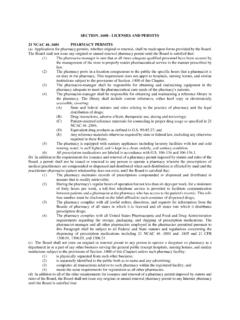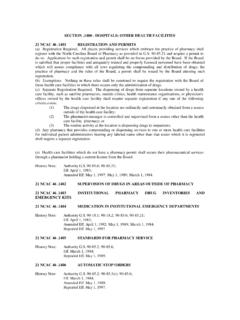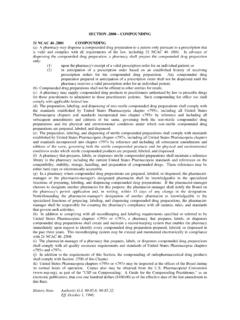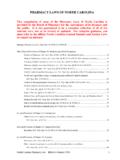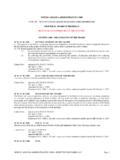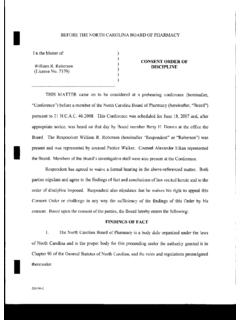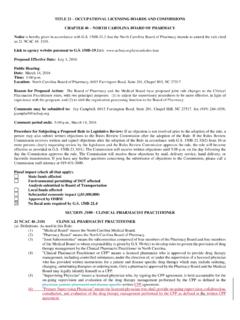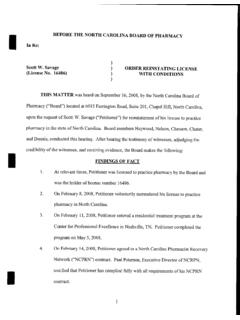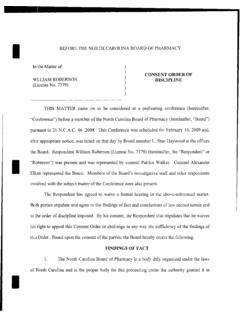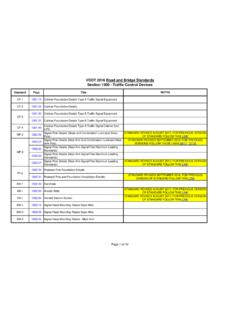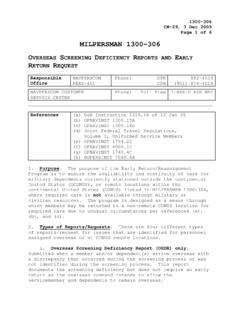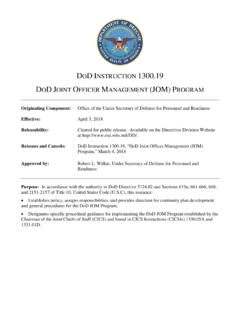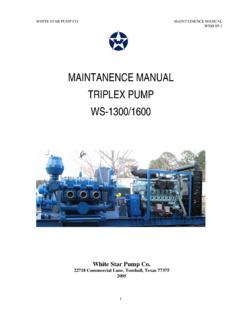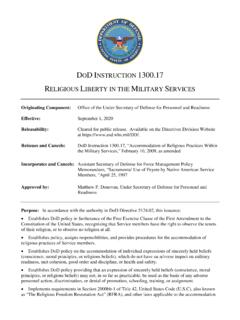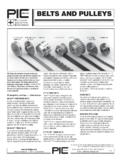Transcription of SECTION .1300 - NCBOP Homepage
1 SECTION .1300 - GENERAL DEFINITIONS 21 NCAC 46 .1301 SCOPE OF DEFINITIONS 21 NCAC 46 .1302 BOARD: OFFICERS 21 NCAC 46 .1303 PHARMACY PERMIT 21 NCAC 46 .1304 DRUGGIST 21 NCAC 46 .1305 PHARMACY INTERN 21 NCAC 46 .1306 DULY APPROVED SCHOOL OR COLLEGE OF PHARMACY 21 NCAC 46 .1307 GRADUATE/APPROVED SCHOOL/COLLEGE OF PHARMACY 21 NCAC 46 .1308 TWO YEARS COLLEGE WORK 21 NCAC 46 .1309 INDULGENCE IN THE USE OF DRUGS 21 NCAC 46 .1310 SUPERVISION 21 NCAC 46 .1311 INSTITUTIONAL PHARMACY 21 NCAC 46 .1312 PHARMACIST MANAGER 21 NCAC 46 .1313 LIMITED SERVICE PHARMACY PERMIT 21 NCAC 46 .1314 APOTHECARY 21 NCAC 46 .1315 DRUGSTORE 21 NCAC 46 .1316 UNDERGRADUATE PROFESSIONAL DEGREE IN PHARMACY History Note: Authority ; ; ; ; ; (b); ; (3); (a); Eff.
2 April 1, 1983; Amended Eff. January 1, 1985; March 1, 1984; April 1, 1983; Repealed Eff. May 1, 1989. 21 NCAC 46 .1317 DEFINITIONS The definitions of various terms used in this Chapter are found in 90, Article 4A, and as follows: (1) Ambulation Assistance Equipment. Devices that aid in walking, excluding canes, crutches, and walkers. (2) Approved School or College of Pharmacy. A school or college of pharmacy accredited by the American Council on Pharmaceutical Education, or a foreign school with a professional pharmacy degree program of at least five years approved by the Board pursuant to (3) Auxiliary Drug Inventory. A secure, segregated, supplementary source for drugs to be used solely for the purpose of providing adequate drug availability when the pharmacy is closed or the pharmacist is unavailable.
3 (4) Board. As defined in (b). (5) Certified technician. A technician who has passed a pharmacy technician certification board exam, or its equivalent, that has been approved by the Board according to the rules in this Chapter. (6) Consultant Pharmacist. A licensed pharmacist who, in collaboration with the supervising physician and nurse practitioner or assistant to the physician, develops a retrospective drug utilization review program that: (a) reviews the appropriateness of the choice of medication(s) for the patient and the patient's therapeutic regimen, including choice of medication, dose, frequency, and route of administration; (b) identifies and resolves therapeutic duplication in the patient's medication regimen; and (c) considers patient-specific medication contraindications.
4 The consultant pharmacist holds himself available for consultation in person, by telephone, or by other means of direct communication at all times when drugs are dispensed. (7) Diagnostic equipment. Equipment used to record physiological information while a person goes about normal daily living or while asleep in order to document a disease process. Early pregnancy tests (EPTs), thermometers, glucose meters, and cholesterol equipment are not included as diagnostic equipment. (8) Drug review or Pharmaceutical care assessment. An onsite review of a patient's or resident's record by a licensed pharmacist that involves interpretation and evaluation of the drug therapy and other pharmaceutical care services to achieve intended medication outcomes and minimize negative effects of drug therapy.
5 (9) Duplicate as used in Any license, permit, or registration issued or reissued by the Board that is identical to a previously issued license, permit, or registration, including a permit reissued due to a change in pharmacist-manager. (10) Emergency Drugs. Those drugs whose prompt use and immediate availability are generally regarded by physicians as essential in the proper treatment of unforeseen adverse changes in a patient's health or well-being. (11) Employee. A person who is or would be considered an employee under the North Carolina Workers' Compensation Act. This definition applies to locations both within and outside of this State holding pharmacy or device and medical equipment permits and without regard to the number of persons employed by the permit holder.
6 (12) Executive Director. The Secretary-Treasurer and Executive Director of the Board. (13) Graduate of an Approved School or College of Pharmacy. A person who has received an undergraduate professional degree in pharmacy from an approved school or college of pharmacy, or a person who has graduated from a foreign professional school of pharmacy and has successfully completed the Foreign Pharmacy Graduate Equivalency Examination offered by the National Association of Boards of Pharmacy and the Test of English as a Foreign Language. (14) HMES. Home medical equipment supplier. (15) Health Care Facility. Any organization whose primary purpose is to provide a physical environment for patients to obtain health care services.
7 This shall include: (a) a hospital; (b) a long-term care facility; (c) a mental health facility; (d) a drug abuse treatment center; (e) a penal institution; or (f) a hospice. (16) Health Care Facility Pharmacy. A pharmacy permitted by the Board that provides services to a Health Care Facility. (17) Indulgence in the Use of Drugs. The use of narcotic drugs or other drugs affecting the central nervous system or the use of intoxicating beverages to an extent as to deprive the user of reasonable self-control or the ability to exercise such judgment as might reasonably be expected of an average prudent person. (18) Internet Pharmacy. (a) A pharmacy that maintains an Internet web site for the purpose of selling or distributing prescription drugs; or (b) A pharmacy that uses the internet, either itself, or through agreement with a third party, to communicate with or obtain information from patients; uses such communication or information, in whole or in part, to solicit, fill or refill prescriptions; or otherwise uses such communication or information, in whole or in part, to engage in the practice of pharmacy as defined in (r).
8 Notwithstanding Sub-items (a) and (b) above, a pharmacy shall not be deemed an Internet pharmacy if it maintains an Internet web site for the following purposes only: (i) To post mere advertisements that do not attempt to facilitate, directly or through agreement with a third party, an actual transaction involving a prescription drug; (ii) To allow a patient to communicate a request for a refill of a legitimate prescription originally filled by the pharmacy that maintains the Internet web site; (iii) To allow a customer to research drug interactions and clinical pharmacology information; or (iv) To allow a patient to send an electronic mail message to a pharmacist licensed in North Carolina.
9 (19) Limited Service Pharmacy Permit. A pharmacy permit issued by the Board to an applicant who wishes to render in an institutional setting pharmaceutical services not limited to scope and kind but to time and conditions under which such services are rendered. (20) Medication Therapy Management Services and Related Functions. Services and functions included in the practice of pharmacy as part of monitoring, recording and reporting drug therapy and device usage. (21) Medication Administration Record. A record of drugs administered to a patient. (22) Medication Order. An order for a prescription drug or other medication or a device for a patient from a person authorized by law to prescribe medications.
10 (23) Mobility equipment. Devices that aid a person in self-movement, other than walking, including manual or power wheelchairs and scooters. (24) Oxygen and respiratory care equipment. Equipment or devices used to administer oxygen or other legend drugs, maintain viable airways or monitor cardio-respiratory conditions or events, including the following: (a) compressed medical gases; (b) oxygen concentrators; (c) liquid oxygen; (d) nebulizers; (e) compressors; (f) aerosol therapy devices; (g) portable suction machines; (h) nasal continuous positive airway pressure (CPAP) machines; (i) Bi-phasic positive pressure devices (BiPAP); (j) infant monitors, such as apnea monitors and cardio-respiratory monitors.
